General Biology II Exam I Review
1/387
There's no tags or description
Looks like no tags are added yet.
Name | Mastery | Learn | Test | Matching | Spaced |
|---|
No study sessions yet.
388 Terms
Taxomy (Binomial Nonmenclature)
The science of naming, classifying organisms
Phylogeny
Evolutionary history of a species or group of related species → only represents a evolutionary hypothesis
Taxon
General name for group at any level
Domain to Species
This means smaller groups within larger groups
Evolution
Change of alleles overtime that involves a population
Natural Selection
This means differential survival and adaptations based on phenotypes.
Better survival skills
What do better alleles mean for organisms?
Monophyletic
Ancestor and all descendants (true tree)
Paraphyletic
Ancestor and some descendants
Polyphyletic
Missing a common ancestor
Nonliving, No cells, metabolism requires a host, and replication requires a host
What are some characteristics of viruses
DNA & RNA
What are the types of genetic material that you can find in viruses?
20-300 nm
What is the typical size for viruses
2-1000 genes
What is the number of genes in viruses?
Linear, circular, segmented
What is the typical shape of the genetic material in viruses?
Caspid
The protein coat that surrounds DNA/RNA in viruses that determines what host the virus can attach to
capsomeres
What is the caspid made out of?
A parasitic relationship
What type of relationship do viruses need in order to survive?
Envelopes
These are acquired during the process of budding out in the host cell (exiting) which surrounds the caspid, hosts glycoprotein, virses proteins, and is formed from the phospholipid bilayer
Host
Species or tissue that is infected
1) Virus binds and finds to cell through receptors
2) Genomes will enter the host cell
3) Host copies viral genome and make proteins
4) New virus assembles
5) virus is released
What are the typical steps of viruses replicating?
Virulent Phage
This type of phage will kill the host at the end of the cycle ( the lytic cycle)
Temperate Phage
This can either be lytic or lysogenetic cycle
Lysogenic Cycle
Replicates cycle as virus DNA hides in the host for many cycles as a prophage
The host DNA
Where is the viral DNA hidden within
Viral DNA also reproduces
When the host bacteria reproduces, what happens to the viral DNA?
Lytic Cycle
This will kill the host in the end of the cycle
Attachment
First step of Lytic Cycle?
Genome will enter the cell and host cell DNA degrades
Second step of Lytic Cycle?
Viral proteins are produced and replicated as viral DNA
After the host cell DNA degrades, what happens after?
They begin to assemble and virus is released
After replication and protein production, what happens to the viruses?
It is incorporated as a prophage
Although the first 2 steps are similar to a lytic cell in the Lysogenic cycle, what happens to the viral DNA?
Through integrating virus instructions into host DNA
How does bacteria reproduce within the hidden prophage?
Can be done through environmental changes in the cell
How can a phage doing the lysogenic cycle make new phages?
3.5 bya
When did prokaryotes first appear?
Prebiotic soup or iron sulfur
How can you hypothesize life first originating?
Nucleoids
Where is DNA located in prokaryotes that is also a single haploid chromosome?
Ribosomes, Nucleoid, Cytosol, Cell membrane & cell wall, enzymes (respiration and photosynthesis), and plasmids
What parts do prokaryotes have?
Plasmids
Extra DNA in prokaryotes
Cell Wall
This function is to protect the prokaryote, maintain cell shape, and prevent bursting into hypotonic solution (in photosynthetic bacteria)
Peptidoglycan
This is in bacteria in the cell wall.
Horizontal Transmission
Transfer of genetic material between individuals of the same offspring
Vertical Transmission
Transfer of Genetic material from parent to offspring
Gram Straining
This is a 2 step process strain wash to identify bacteria based on their cell wall
Gram positive (purple)
This color contains thick cell walls with lots of peptidoglycan
Gram negative (pink)
This has a thin peptidoglycan layer that has an outer membrane of lipopolysaccharides
This means movement
Taxis
Flagella
Although this is found in all domains, this doesn’t show up in analogous (convergent evolution)
Through ATP synthase and pumping of protons (no cellular membrane)
How can the flagella be powered up for movement?
Binary Fission
How do prokaryotes divide?
Rapid mutations or different gene transfers, genetic recombination, etc.
How can prokaryotes effectively be genetically unique when they only undergo binary fission?
Horizontal Gene Transfer
Transferring genetic material from one cell to another
Vertical Gene Transfer
Transferring genetic material from parent to offspring
Transformation
When DNA from surroundings incorporate foreign DNA as plasmids or into the bacterial genome within the same species
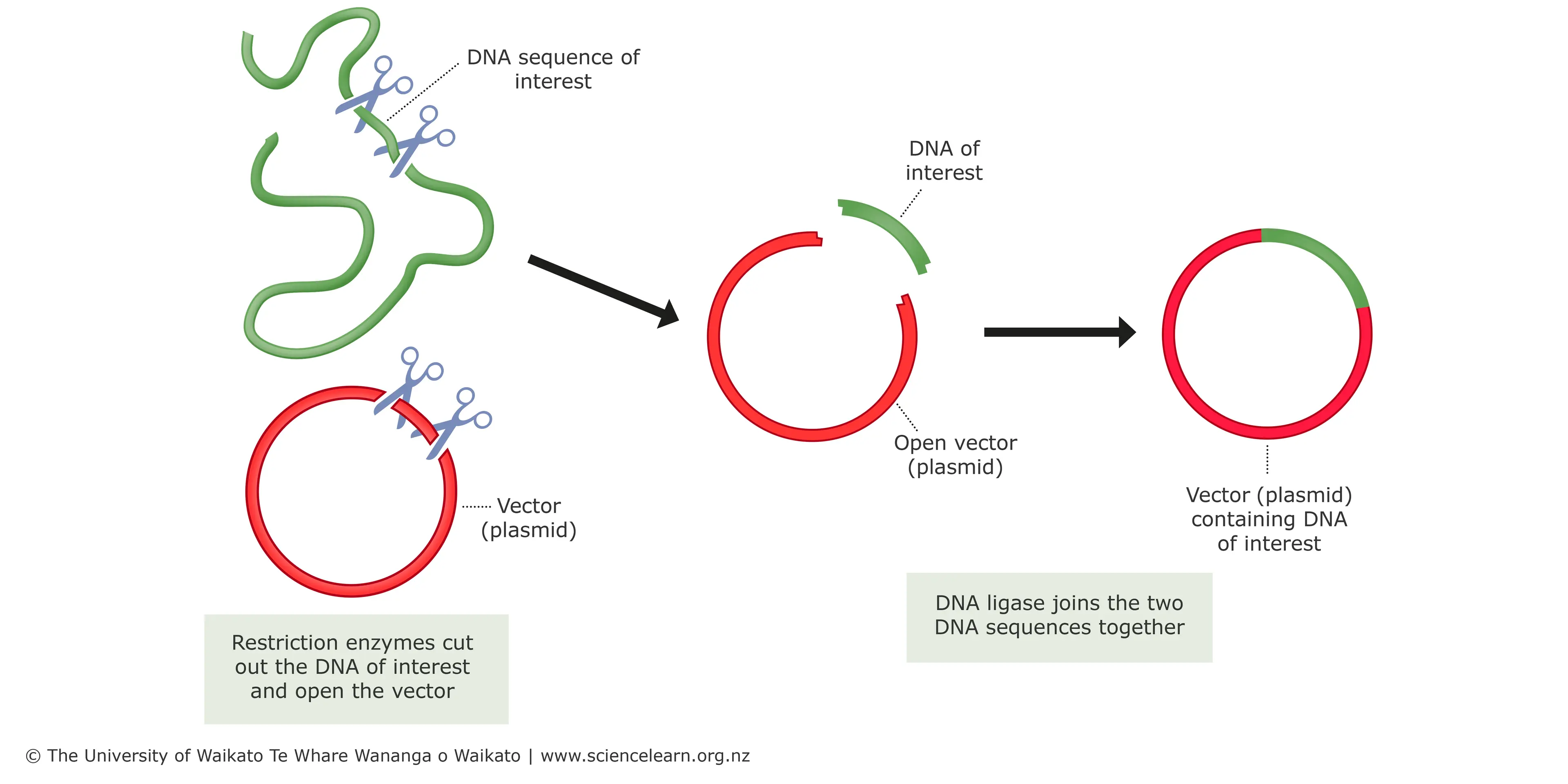
Transduction
Phages transfer bacterial DNA where the bacteria is now using the virus to transmit bacterial DNA- Generally same species of bacteria
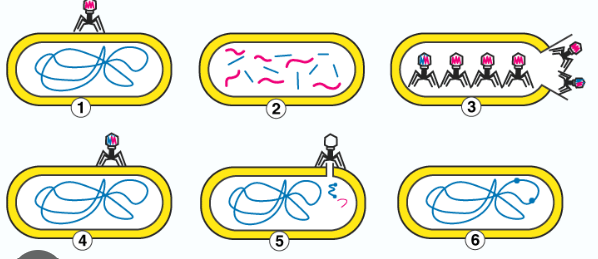
Conjugation
DNA shared between two individual species (different)
F (fertility) Factor F+ = allele to grow pilus
F+ bacterium grows a pilus
Transfers DNA plasmid (including F+ allele) to another bacteria

Carbon and Energy
What are the main energy sources used in prokaryotes?
Phototrophs
Light centered energy source
Chemotrophs
Chemical reactions
Autotrophs
This has a carbon source of CO2
Heterotrophs
Uses the carbon source as food
Chemoheterotrophs
This eats others as food and does chemical reactions (us)
Obligate Aerobe
Needs Oxygen to survive
Obligate Anaerobe
If oxygen is used, WILL KILL! Can only go through fermentation
Facultative Anaerobe
This can live with or without oxygen
2 (bacteria and archaea)
How many domains of prokaryotes do we have?
4
How many groups of archaea do we have?
5
How many groups of bacteria do we have?
Horizontal Gene Transfer
In order to obtain this prokaryotic diversity, what type of gene transfer do we do?
Proteobacteria
These are gram negative and are considered the ancestor of mitochondria (includes mitochondria and other mutualistic prokaryotes)
Cyanobacteria
Photoautotrophs that are gram negative that have phytoplankton and are typically ancestors of chloroplasts
Extremophiles
Prokaryotes that have cell walls (no peptidoglycan) and no nucleus
Halophiles
Archaea that prefers to live in high salty environments
Thermophiles
Archaea that preferably wants to live in very hot environments
Methanogens
These are unique to archaea that releases methane by product metabolism AND CANNOT BE POISONED BY O2
Plasmids
Extra DNA/foreign DNA taken up into the bacterial genome
Horizontal Gene Transfer
What type of gene transfer was found in prokaryotes when they are divided into 2 domains?
This is unknown
What is the root of the Eukarya?
Polytomy
Is the Eukaryotic tree a polytomy, monophyletic or paraphyletic?
Evolutionary time
When a phylogenetic tree proceeds from left to right, what does that mean?
Derived Traits
New traits that have just emerged after the most recent branch point. This is what H is to stramenopiles
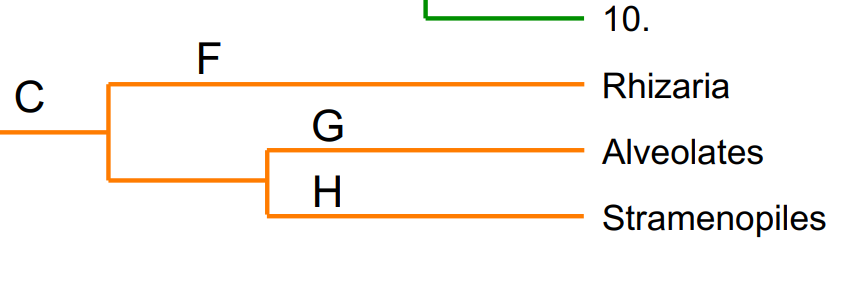
Ancestral Traits
Old traits that emerged before the most recent branch point.

Eukaryotes
This has a size of 10-100 micrometers, has a cytoskeleton, a nucleus, membrane bound organelle and endosymbiosis of a mitochondria
An endosymbiotic relationship where they will all live together in symbiosis
What relationship do all eukaryotes have?
Cytoskeleton
This part helps with structure, support and motility
Nucleus, Membrane bound organelles, and endosymbiosis of a mitochondria
What are 3 derived traits of an eukaryotic cell?
Primary Endosymbiosis
When an eukaryote engulfs a prokaryote to result in a heterotrophic eukaryote with mitochondria.
Alpha proteobacteria
This was consumed by archaea to create mitochondria (endosymbiotic event in 1st primary endosymbiosis)
Cyanobacteria
What did heterotrophic eukaryotes engulf to help chloroplasts arise? (Secondary endosymbiotic event)
Secondary Endosymbiosis (2o)
This is the process when small eukaryotes are engulfed by large eukaryotes
Serial Endosymbiosis
Multiple endosymbiosis events at once (both mitochondria and chloroplast were once free living before being engulfed)
2o plastid
Any organelle resulting from 2o endosymbiotic event
Monophyletic
Is eukaryotic evolution monophyletic, paraphyletic, or polyphyletic?
Protists
These are paraphyletic where they are known as the first eukaryote that arose through endosymbiosis, mostly unicellular (some can be multicellular), complex cell organization, and some examples are heterotrophs, phototrophs, and autotrophs
Primary endosymbiotic event of mitochondria forming
A (Eukarya)
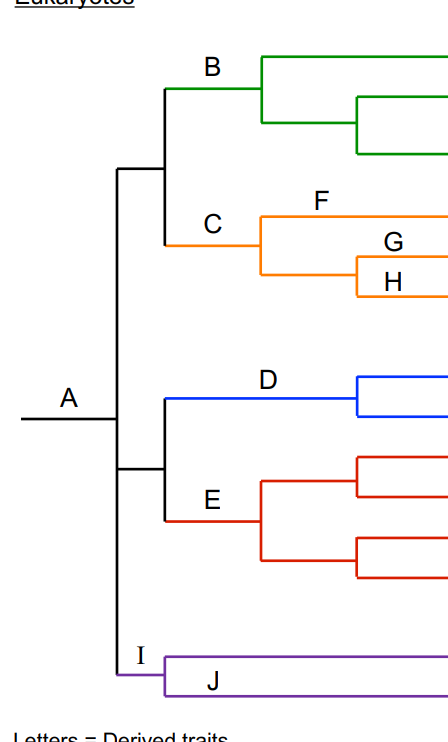
Archaeaplastida
2 (Eukarya)

Eukarya
1 (what is this phylogenetic tree grouping)
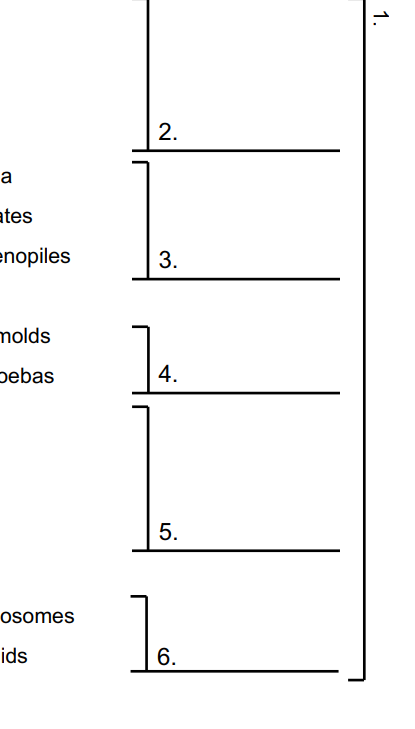
SAR
3 (Eukarya)

Amoebozoa
4 (Eukarya)

Opisthokonta
5 (Eukarya)
